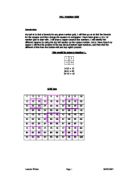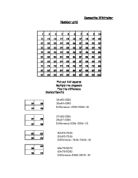GCSE Mathematics
Coursework
Number Grid
Prepared by: Scott Bayfield
This investigation relates to the product differences in different sized areas within a 10 x 10 number grid.
For example:
A 2 x 2 grid has been selected inside of the above grid. The objective of the investigation is to find the product of the bottom right and the top left numbers in the selected area. To calculate the product I must:
Multiply the number in the bottom right cell with the number in the top left cell.
The product difference is 10. This figure remains the same no matter where I carry out the above sum when used on a 2 x 2 grid within a 10x10 matrix. For example:
Example 1
(75 x 86) - (76 x 85) = 10
Example 2
(1 x 12) - (2 x 11) = 10
Example 3
(17 x 28) - (18 x 27) = 10
These examples prove that the answer remains the same regardless of where we complete the sum with in the grid.
In an effort to expand the investigation, I decided to carry out the same test but by varying the size of the grids within the 10 x 10 matrix. I first of all increased the size of the cell selection to a 3 x 3 area. My results were as follows:
Coursework
Number Grid
Prepared by: Scott Bayfield
This investigation relates to the product differences in different sized areas within a 10 x 10 number grid.
For example:
A 2 x 2 grid has been selected inside of the above grid. The objective of the investigation is to find the product of the bottom right and the top left numbers in the selected area. To calculate the product I must:
Multiply the number in the bottom right cell with the number in the top left cell.
The product difference is 10. This figure remains the same no matter where I carry out the above sum when used on a 2 x 2 grid within a 10x10 matrix. For example:
Example 1
(75 x 86) - (76 x 85) = 10
Example 2
(1 x 12) - (2 x 11) = 10
Example 3
(17 x 28) - (18 x 27) = 10
These examples prove that the answer remains the same regardless of where we complete the sum with in the grid.
In an effort to expand the investigation, I decided to carry out the same test but by varying the size of the grids within the 10 x 10 matrix. I first of all increased the size of the cell selection to a 3 x 3 area. My results were as follows:






